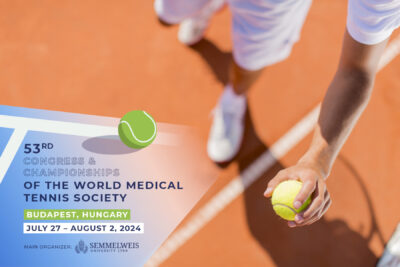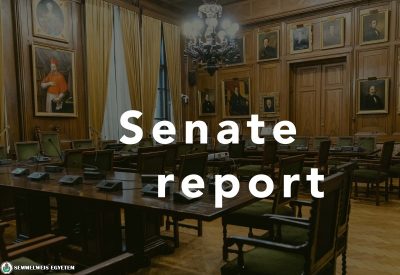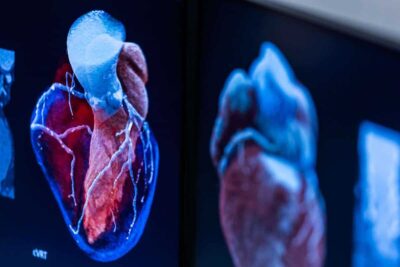“Through his professional achievements and his human greatness, he has set an example to endless numbers of people and provided paternal support to more than a few. I am also personally immensely grateful to be able to count myself among them,” – these were the words of Dr. Béla Merkely, Rector of Semmelweis University and Director of the Városmajor Heart and Vascular Center, when he greeted Dr. Zoltán Nagy, who celebrated his 80th birthday.
In praise of his work he recalled that the professor, as a physician, researcher, lecturer, head of the OPNI and later the National Institute of Neurosurgery, and as a citizen of the university, worked for many years on the understanding and treatment of the brain at a world-class level.
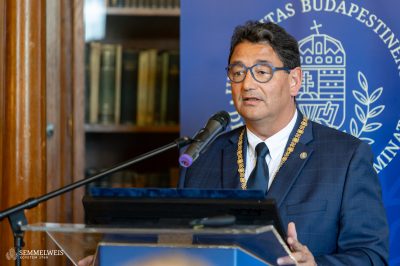
The Rector expressed his pleasure to have met Dr. Zoltán Nagy as a young doctor, who as Director General of OPNI led the development of the telemetry network for stroke care, while his task was the coordination of vascular and cardiac surgery participation at Városmajor. That was their first project, and as he said, he has been impressed ever since by the professor’s dedication and immeasurable devotion to improving patient care.
He described the Városmajor Heart and Vascular Center as a “matter of their heart”, where Dr. Zoltán Nagy worked as a consultant from 1980, and where Professor Sándor Juhász-Nagy hosted his laboratory for a temporary period, and later headed the Vascular Neurology Group. In 2016, he became a member and then Chairman of the University’s Board of Trustees, and since the model change, he has been Chairman of the University’s Public Benefit Supervisory Board. In 2019, in the framework of the 250th anniversary celebrations, Dr. Zoltán Nagy launched the Senior Academy, aiming primarily at the elderly lay public, demonstrating his dedication to the education of the elderly.
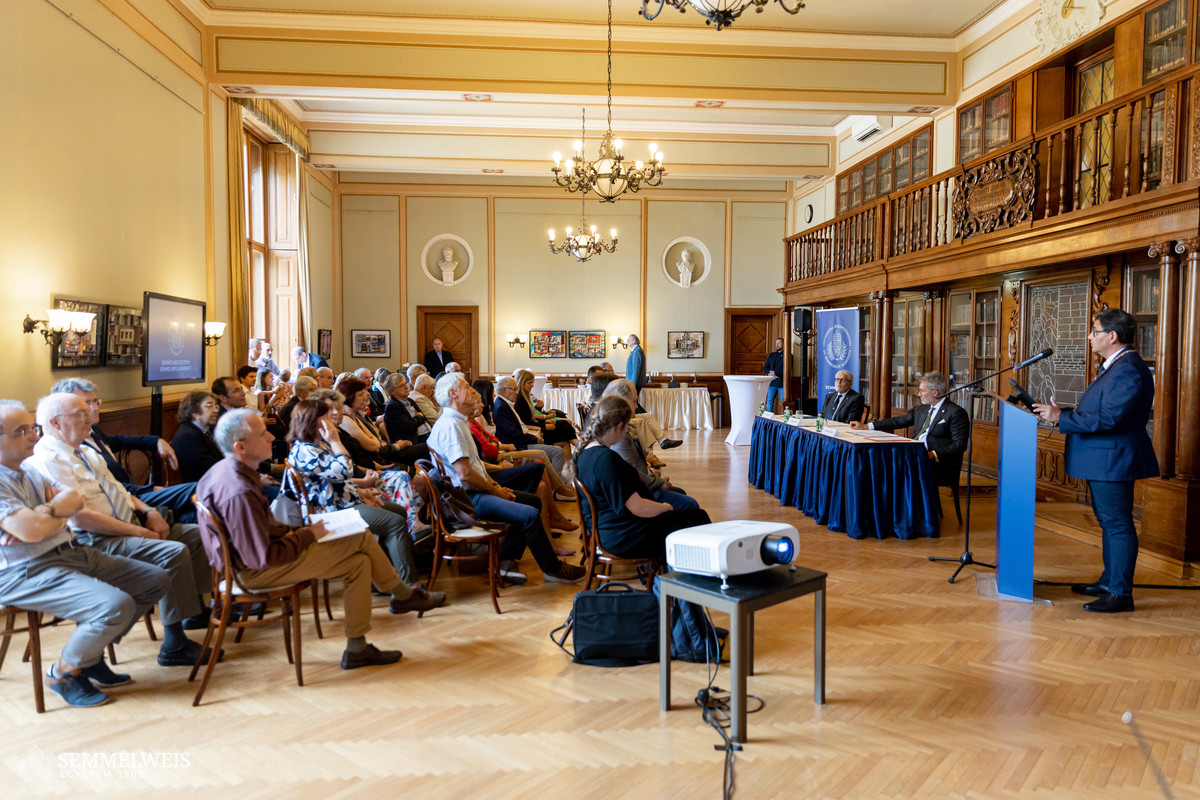
In addition to the professor’s neurobiological research, Dr. Béla Merkely described the organization and development of stroke care in Hungary, and making stroke prevention and treatment a national issue as his most important initiative, and a legacy of his life. Mentioning his painting exhibition last year, he also praised his artistic activities, and on behalf of the Senate of the University, he presented the professor with the Pro Universitate Medal.
Dr. Loránd Erőss, Director General of the National Institute of Mental Health, Neurology and Neurosurgery, emphasized in his laudation that putting any aspect of Dr. Zoltán Nagy’s diverse activities under scrutiny, we see an incredibly energetic personality. As he recalled, at the age of 35 the professor was already head of department at the Department of Psychiatry at Semmelweis University, at 45 he was appointed deputy clinical director, at 49 he was appointed professor, at 52 he was appointed director of the National Centre for Brain Diseases at the OPNI and organized Hungarian stroke care with his colleagues, at 58 he was appointed head of the Department of Neurology at HIETE, and at 60 he was appointed director general of the OPNI. In 2007, after the closure of the OPNI, he founds the Bioelectrical Brain Imaging Research Laboratory at the Faculty of Computer Engineering of Pannonian University, and at the age of 70 he takes over the leadership of the OITI for six months, which became six years.
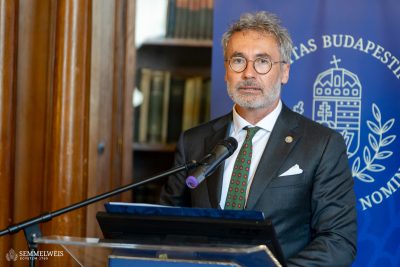
Dr. Loránd Erőss stressed that Dr. Zoltán Nagy is a real integrator, his professional, scientific and community-building ideas are also a testament to his creativity. As a personal experience, he mentioned that he had visited the professor’s home, where an environment created by a Renaissance man unfolds: in addition to plenty of books, manuscripts and paintings, including his own paintings, there is also a harp; a man living in constant temptation to create can be seen in this home.
At the scientific meeting, his students gave lectures: Dr. Gyula Pánczél (Three decades of thrombolysis: from pioneers to routine stroke therapy), Dr. István Gubucz (Mechanical recanalization: a new panacea in neurological care), Dr. Anikó Gaál (Focus on the brain endothelium: the importance of the blood-brain barrier in ischaemic stroke) and Dr. Sándor Nardai (Experimental stroke research: DMT as a new promise for neuroprotection).
Interview with Professor Emeritus Dr. Zoltán Nagy, President of the Hungarian Stroke Society
Still active at 80, what are you working on now?
We continue to work with dimethyltryptophan (DMT), a new molecule in the potential treatment of stroke care, as it reduces neuronal damage, inflammatory response and damage to the blood-brain barrier. I also have many responsibilities as chair of the Public Benefit Committee at the university, I am also on the Research Ethics Committee (ETT-TUKEB) and I am a member of the Review Committee of the Hungarian Accreditation Committee. I hold an annual course for PhD students on the neurobiology of stroke.
In spring, the 6th semester of the Senior Academy, of which you are the professional leader, was held already. Why do you consider the education of the older generation important?
Through my patients, I have seen how older people are becoming increasingly disconnected from their own age. The world is changing, we are experiencing another technological revolution, everything is being renewed, and the elderly are lagging behind, they don’t understand the big changes that have taken place in biomedical science, in clinical care. My slogan was: “let us learn to understand our grandchildren”. I wanted to make people aware of the new research directions, and I created a health education theme that would also promote Semmelweis University in the capital and in the country, so that the public could see how high the level of knowledge is at this internationally renowned university. The courses are free of charge and extremely popular, with 1800 people registering last semester and following the lectures on Zoom.
You are a painter and you also study the neurobiology of image reception. What have you found?
Together with a radiographer-engineer PhD student, we used functional MRI to examine what happens in the brain when a painting is projected to the subject. We knew roughly what to expect, but there was no data on whether the image processing in the brain of a visual artist or a person who was not familiar with painting was the same. There is also little data on whether there is a difference in brain activity between the reception of a non-figurative and a figurative painting, or between a kitsch and a valuable painting. No appreciable differences were found for the latter, but there were differences between abstract and depicting images, and between painters and lay people.
Which painting style do you classify yourself in?
Primarily non-figurative, lyrical abstraction or expressionism. I had masters like Imre Magyarász, Géza Bene or Lajos Sváby, with whom I had a close friendship in his last years. Shortly before his death, he wrote in an email, “You no longer need me, you have become a master”. The recognition of this great artist gave me confidence.
Gábor Kiss
Photo: Attila Kovács – Semmelweis University
